Site menu:
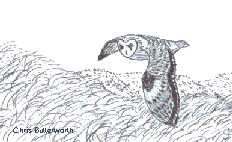
January 2009 Newsletter
Cheshire & Wirral Bird Report 2007.
Hilbre Bird Observatory Report 2007.
North-east Wales Report 2007.
December Bird News.
Forthcoming Events.
Latest Newsletter.
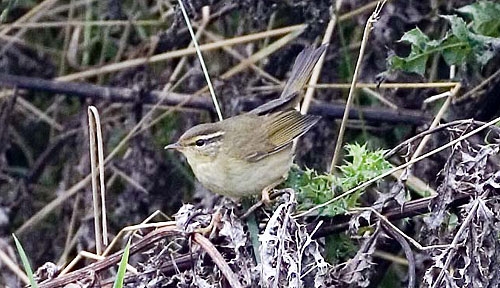
 We’re delighted to say that the annual Bird Report for
2007 is now available. The eye-catching colour front cover this year is of a Grasshopper Warbler in full song. The 176
pages of text include 14 maps, charts and graphs, and 12 beautiful
illustrations from two different artists. As usual, the colour map of the
county forms the centre spread of the Report. A total of 18 colour
photographs, which best capture some of the highlights of the year, are
spread over seven full pages.
We’re delighted to say that the annual Bird Report for
2007 is now available. The eye-catching colour front cover this year is of a Grasshopper Warbler in full song. The 176
pages of text include 14 maps, charts and graphs, and 12 beautiful
illustrations from two different artists. As usual, the colour map of the
county forms the centre spread of the Report. A total of 18 colour
photographs, which best capture some of the highlights of the year, are
spread over seven full pages.
The Report contains articles on two of the three new species recorded
within Cheshire and Wirral in 2007: Desert Wheatear (National Rarity) and
Radde’s Warbler (County Rarity), whilst another article recalls the
excitement of finding the county’s fourth White-tailed Eagle. Back in April
1908 a Kermadec Petrel was reportedly found dead in Cheshire – Hugh
Pulsford’s article discusses this amazing record using the original paper
and photographs, and also looks at the subsequent correspondence
surrounding this review in British Birds – a fascinating ‘whodunnit’.
Following this, Colin Wells looks at the Past, Present and Future of the
RSPB Dee Estuary Nature Reserve; one of the best kept birding secrets is
about to be ‘let out of the bag’ and deservedly reach a wider audience.
Next, David Norman summarises some of the results from the recently
published Cheshire and Wirral Bird Atlas 2004-07 – there have been some
losses, but also some significant gains revealed over the study period.
Finally, the Breeding Bird Survey (BBS) highlights and lowlights spanning
the period 1994-2007 are listed.
All the ‘regulars’ are there: ‘Weather and Bird Review of the Year’; the
full ‘Systematic List of Birds Recorded in Cheshire and Wirral during
2007’, including ‘Category E Species’; ‘Early and Late Dates for Migrants’;
‘BBRC and County Rarities Decisions’; ‘Ringing Report’; ‘Chairman’s
Review’; ‘Database Statistics for 2007’ and finally, advice on the
‘Submission of Records’.
Last, but not least, we have again included a Species Index at the back to
help you quickly look up your favourite species. This will be particularly
useful to those not familiar with the new Systematic List order now
adopted.
The Report costs £7.00 + £1.20 p&p and copies are available from:
David
Cogger
113 Nantwich Road, Middlewich, Cheshire, CW10 9HD
Email: davidcogger@cawos.org
Hilbre Bird Observatory Report 2007
Out soon only £5 incl p&p

Left -
Red-breasted Flycatcher - Hilbre October 2007 (Steve Williams), Right - Grey
Phalarope, September 2007 |
Send a cheque for £5 made out to 'Hilbre Bird Observatory' to:
|
North-East Wales Bird Report 2007
The Clwyd Bird Recording Group has once
again produced an excellent and informative report for 2007, covering Denbighshire and Flintshire. This year marked the 100th
anniversary of H.E. Forrest's The Fauna of North Wales and the
opportunity has been taken to make some fascinating comparisons with the
status of the bird species, now and then. Where sensible comparisons can be
made the report shows that the status of 51 species have had favourable
changes and 58 species unfavourable changes.
covering Denbighshire and Flintshire. This year marked the 100th
anniversary of H.E. Forrest's The Fauna of North Wales and the
opportunity has been taken to make some fascinating comparisons with the
status of the bird species, now and then. Where sensible comparisons can be
made the report shows that the status of 51 species have had favourable
changes and 58 species unfavourable changes.
As usual there is a detailed and full systematic list which includes black and white photos, maps and tables. There are also 17 full colour photographs and articles on Aberduna Nature Reserve, The Little Terns of Denbighshire, Confod - Focussing wildlife data for North Wales, WeBS counts, Ringing Report, Birding Highlights 2007 and an article on the aforementioned The Fauna of North Wales published in 1907.
Copies of this report are available at the RSPB
Reserves at Inner Marsh Farm and Clwyd. To obtain a copy by post see
details on the CBRG website
http://www.cbrg.org.uk/9Reports.html
, scroll down to the bottom of the Reports page where you can click on
the email address of the county recorder, he will send you details of how
to obtain a copy.
Richard Smith
December Bird News
We did have some of the hoped for Waxwings but they remained frustratingly elusive - there were five reports of single birds all of which only stayed no more than a day, and one report of a flock of five, seen from the top of a bus and not relocated.
The Great Northern Diver which arrived on West Kirby Marine Lake last month was last reported on the 16th, presumably the same bird was also off Hilbre a couple of times. Brent Geese stabilised around the 130 mark on Hilbre, max was 133 recorded on the 7th and 22nd, these included two dark-bellied birds.
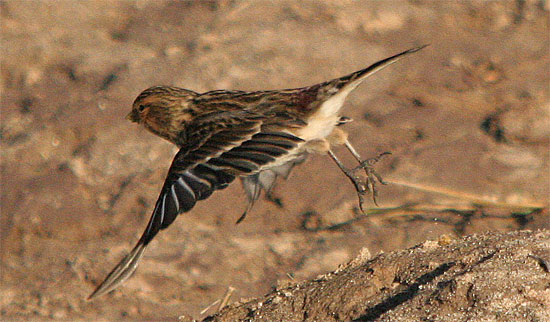
A small flock of 13 Twite on Thurstaston Shore caused some excitement. Although fairly regular on the Welsh side of the estuary they are quite rare on the English side. They were first noted on the 19th during some strong westerly winds, and stayed for the rest of the month. 20 Twite were on the Connah's Quay reserve on the 2nd. Also at Thurstaston were good numbers of Pintail, max 970, which frequented the gutter close to the shore at low tide. This is a really good number at a site where a few years ago we never got more than 20 or so. An hour or two after high tide was the best time to see the Black-tailed Godwits busily feeding close to the beach at Thurstaston, maximum of 1,500 was reached on the last day of the month. Around a couple of thousand were counted at Point of Ayr with many feeding in the nearby fields.
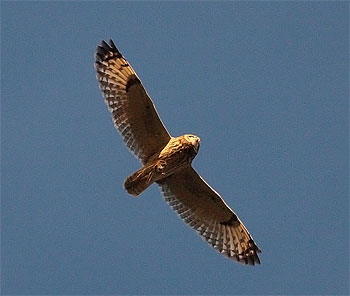
Good counts of six Hen Harriers were observed coming in to the roost site at Parkgate on at least two dates, these were one adult male, one sub-adult male and four ringtails. This is the highest number since 1991 when six were also on the estuary, the last higher count was of seven in 1981. A Marsh Harrier was recorded over the marshes twice, although it seems to be a bit elusive. Short-eared Owl numbers remained high with a max of 22 at Burton Marsh on the 7th.
Eight Snow Buntings on the beach at Point of Ayr on the 30th was the highest count of the month. Elsewhere, two or three remained about the Little Eye, West Kirby Shore and Red Rocks area. A Black Redstart was also at Red Rocks towards the end of the month. A Richard's Pipit was an excellent find on Parkgate Marsh on the 16th, often flying onto the nearby golf course. It was last reported on the 26th.
As for the previous couple of winters there is a large flock of Great Crested Grebes off North Wirral, max count was 435 on the 15th, the second ever highest count for Wirral. They are somewhat difficult to see, let alone count, as they are quite some way offshore and you need ideal conditions - a high spring tide, flat calm and good light. But no doubt this relatively newly discovered flock is one of the largest in the country. Those better than me at spotting rare grebes might well see one or two among the Great Cresteds!
What to expect in January
As I write this on the 1st we are in the middle of a prolonged cold spell, if it persists through the month it will be interesting to see its effect on the birds. This is certainly the longest cold spell we've had since Little Egrets arrived here in good numbers - no doubt helped by the run of mild winters, so maybe we can expect a large drop as they head south to warmer climes. Expect to see cold weather movements of birds such as thrushes and Lapwings, and if North Sea coasts are frozen we may well get a dramatic increase in wader numbers, particularly Knot. With inland waters frozen we should see a big increase in Teal and other wildfowl.
Snow in Norfolk may well trigger a large movement of Pink-footed Geese heading towards south Lancashire, many of these might well fly over the Dee Estuary. As this may involve several thousand birds it can be a spectacular sight. Last January we saw Brent Geese increase to a record 171, I would expect a similar maximum this winter - maybe more.
After a poor autumn in 2008 for high spring tides we see a welcome return to 9.9m+ tides mid-month. If the weather reverts back to our 'normal' wet and windy conditions we should see the tide covering the marsh at Parkgate - with such large numbers of Short-eared Owls around this winter it will be a fantastic sight. If the current weather conditions of high pressure and east winds persist then better birdwatching should be had at Riverbank Road, Heswall, where the tide comes in much more readily than at Parkgate - and we should still see Short-eared Owls, Hen Harriers and large numbers of waders and wildfowl.
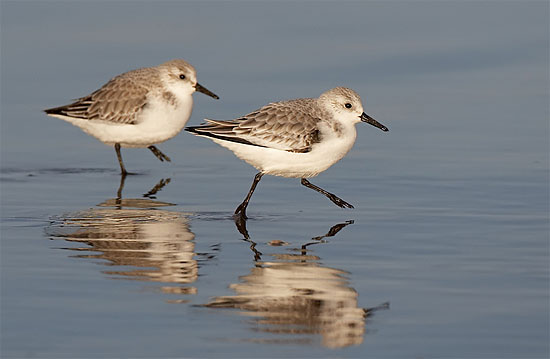
Forthcoming Events
January Highest Spring Tides (Liverpool)
Also see
Tides page.
12th January, 11.53hrs (GMT), 9.9m.
13th January, 12.40hrs (GMT), 10.0m.
14th January, 13.27hrs (GMT), 9.9m.
Forthcoming Events
Organised by the
Wirral Ranger Service ,
Flintshire Countryside Service and/or the RSPB:
All these events and walks have bird interest, even those not advertised
specifically for birdwatching. No need to book for these events unless
specified - please check below.
Saturday 10th January 9:30am start (HW 10am, 9.2m).
‘Birdwatch at King’s Gap, Hoylake’
Come along to Hoylake Foreshore and join members of the Coastal Rangers,
the Dee Estuary Voluntary Wardens and the RSPB and see what birds can be
seen feeding on the outgoing tide. This event is suitable for all the
family to enjoy. All children under 8 must be accompanied by an adult.
Dress warmly and bring binoculars if you have them. Meet at King’s Gap on
Hoylake Promenade. For further enquiries Tel: 0151 678 5488.
Tuesday 13th
January 11:15am
Parkgate Birdwatch
High tide at Parkgate is the best time to discover the hidden treasures of
the Dee Estuary RSPB reserve. As the sea covers the marsh many hundreds of
waders and wildfowl will be brought closer to the shore, there should be
good views of Short-eared Owls and various raptors, including Hen Harriers
and Peregrines. If the tide reaches the wall, small mammals
such as voles, shrews and possibly water rails are flushed out. Meet at
the Old Baths car park overlooking the reserve at Parkgate, close to The
Boat House pub (HW 12:40, 10.0m). No need to book.
Sunday 18th
January 3pm
Parkgate Raptor Watch
Come along and watch birds of prey with the experts. See the graceful hen
harriers coming in to roost on the RSPB reserve. Other birds of prey we
hope to see are merlin, peregrine, sparrowhawk, short-eared owl and
barn owl. Meet at the Old Baths car park, which overlooks the Dee Estuary
RSPB Reserve at Parkgate, close to The Boat House pub. No need to book.
Wednesday 28th January 2009 9.30am start
Mud Matters
Join the Rangers as they follow the rising tide along
Thurstaston Shore.
As the channels and gullies of the mudflats fill many Redshank, Knot,
Curlew and Dunlin will be forced into the open and Pintail will start to
drift towards the Heswall Marshes. We will then return to the Visitor
Centre via Heswall Fields and the Wirral Way where we will look for
hedgerow and farmland birds.
No need to book. Meet at the Wirral Country Park Visitor Centre,
Thurstaston.
For more info: (0151) 648 4371/3884.
Friday 30th January
‘Geese and Waders on Hilbre Island’
Join the Coastal Rangers and staff from the RSPB for a high tide visit to
Hilbre
Island. Among the usual species of wading birds, we should encounter Purple
Sandpipers and also good numbers of Brent Geese. (Please note this is a high
tide visit to Hilbre and we will be cut off from the mainland). There is a £2.50
charge for this event. Sorry no dogs. Please book early as there are limited
places available. Tel: 0151 648 4371/3884.S
Saturday 31st January
Guided Wildlife Walk around the Hoylake Langfields/Carr Fields
(Hoylake end).
A walk will be led by Susan Craggs following the public footpaths from Hoylake
to West Kirby across the Hoylake Langfields. Gilroy Nature Park will be visited
including the adjacent flooded field which is usually full of waders and
wildfowl. This area is rich in birdlife and
includes roosting and feeding waders, wildfowl and numerous species of
passerines which use the overgrown hedges and wet fields to feed on.
This wildlife rich farmland, part of the Green Belt, is currently under threat
from development by Wirral Borough Council with plans to build a large 'Golf
Resort', we believe this would include a sports complex and large Hotel - this is a chance
to see what would be lost to what many locals think is an inappropriate
development.
Parking is available in Hoylake Station Park and Ride, meet 1.30pm at Car Park
entrance, return for about 4pm. Wellington boots are recommended, dogs must be kept on leads.
Richard Smith for further details.
Tuesday 10th February 2009 9am start
Mud’n’Marsh
Join the Rangers down at Banks Rd, Lower Heswall where the mudflats of the
Dee meet the marsh for a high tide birdwatch (HW 1138hrs, 10.0m). From our elevated vantage
point on the shore we will watch 1000’s of waders being forced off the
mudflats by the rising tide and into the safety of the marsh. No need to
book, meet at Banks Rd car park, Lower Heswall.
For more info: (0151) 648 4371/3884.
Tuesday 10th
February 10:15am
Parkgate Birdwatch
High tide at
Parkgate is the best time to discover the hidden treasures of
the Dee Estuary RSPB reserve. As the sea covers the marsh many hundreds of
waders and wildfowl will be brought closer to the shore, there should be good
views of Short-eared Owls and various raptors, including Hen Harriers and
Peregrines. If the tide reaches the wall, small mammals
such as voles, shrews and possibly water rails are flushed out. Meet at
the Old Baths car park overlooking the reserve at Parkgate, close to The
Boat House pub (HW 11:38, 10.0m). No need to book.
Wednesday 11th
February 11:00am
Parkgate Birdwatch
High tide at
Parkgate is the best time to discover the hidden treasures of
the Dee Estuary RSPB reserve. As the sea covers the marsh many hundreds of
waders and wildfowl will be brought closer to the shore, there should be
good views of Short-eared Owls and various raptors, including Hen Harriers
and Peregrines. If the tide reaches the wall, small mammals
such as voles, shrews and possibly water rails are flushed out. Meet at
the Old Baths car park overlooking the reserve at Parkgate, close to The
Boat House pub (HW 12:23, 10.1m). No need to book.
Thursday 12th
February 11:45am
Parkgate Birdwatch
High tide at
Parkgate is the best time to discover the hidden treasures of
the Dee Estuary RSPB reserve. As the sea covers the marsh many hundreds of
waders and wildfowl will be brought closer to the shore, there should be
good views of Short-eared Owls and various raptors, including Hen Harriers
and Peregrines. If the tide reaches the wall, small mammals
such as voles, shrews and possibly water rails are flushed out. Meet at
the Old Baths car park overlooking the reserve at Parkgate, close to The
Boat House pub (HW 13.04, 10.0m). No need to book.
Saturday 14 February 2009
Guided Wildlife Walk around the Hoylake Langfields/Carr Fields
(Meols end).
A walk will be led by Susan Craggs following the public footpaths between Meols
and Saughall Massie Road. This area is rich in birdlife and
includes roosting and feeding waders, wildfowl and numerous species of
passerines which use the overgrown hedges and wet fields to feed on.
This wildlife rich farmland, part of the Green Belt, is currently under threat
from development by Wirral Borough Council with plans to build a large 'Golf
Resort', we believe this would include a sports complex and large Hotel - this is a chance
to see what would be lost to what many locals think is an inappropriate
development.
Parking is available near to Meols Station, meet 1.30pm at Fornall's Green Lane,
Meols Station end (next to Meols end of Heron Road. Return for about 4pm.
Wellington boots are recommended, dogs must be kept on leads.
Richard Smith for further details.
Sunday 15th February 3pm
Parkgate Raptor Watch
Come along and watch birds of prey with the experts. See the graceful hen
harriers coming in to roost on the RSPB reserve. Other birds of prey we
hope to see are merlin, peregrine, sparrowhawk, short-eared owl and
barn owl. Meet at the Old Baths car park, which overlooks the Dee Estuary
RSPB Reserve at Parkgate, close to The Boat House pub. No need to book.
|
 |
The blank (UK) Birding Webring is a collection of quality birding web sites that are based in the United Kingdom. Visit the webring homepage for more information, or A complete list of all the sites in the webring is available by clicking here. previous site in ring : random site in ring : next site in ring |
